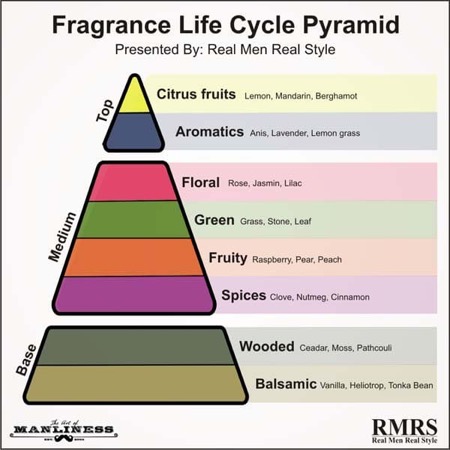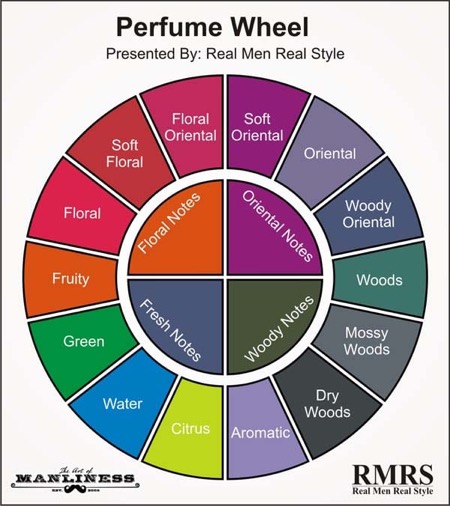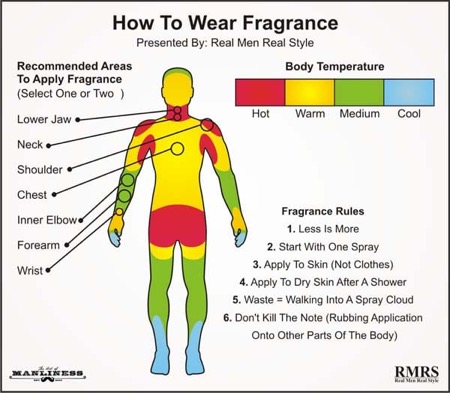A Man’s Guide to Fragrance: How to Choose and Wear Cologne
Friday, October 27, 2017 - Filed in: General Interest

On my recent trip to Atlanta I was the last person to board my plane.
I asked the stewardess if I could check my bag, and as she reached over to grab my luggage she immediately looked up and said, “You smell wonderful!”
Now I’m a married man, but I have to admit that this compliment from a beautiful woman had me feeling good the entire flight.
And that’s why this matters, gentlemen.
Fragrance is an invisible part of our personal style, and it has a powerful effect on how people see and remember you.
A good cologne offers numerous benefits, from making you more attractive, to helping you feel less stressed and more confident.
And yet 80% of men do not wear fragrance on a regular basis!
Why is that?
I feel the main reason is a lack of basic information and education. Most men who use colognes and perfumes do so because they had a father or role model who introduced them to the practice. Here in the U.S., the industry is dominated by women and most men are ignorant of the terminology.
Additionally, there is a strong fear of overusing fragrance and the repercussions it can have on our reputation. No one wants to be known as “Pepe Le Pew.”
Thankfully, a working knowledge of how to understand fragrance and wear it well is easily within reach, and we’ll provide it to you today!
Why Wear Fragrances
Wearing a fragrance will increase not only your attractiveness, but your confidence with women (and in general) as well.
Wearing a fragrance will make you more attractive to women. In choosing a mate, smell is most important for women. In a European study it was shown that while visual cues are most important for men in choosing a woman, scent is the most powerful factor for women in choosing men. A man uses his eyes first and foremost, while a woman uses her nose (even if she doesn’t know it!).
Additionally, women have a better and more finely-tuned sense of smell. Starting at birth, women consistently outperform men in smell tests, in both identification and detection. In fact, women’s noses are even specifically tuned to be sensitive to male pheromones (scented sex hormones). Fragrances combine with these scents to form an even more memorable and attractive olfactory experience.
A fragrance can foster deeper emotional connections with people. Smell is the most powerful sense. It is in fact 150,000 times more sensitive than your vision, and capable of perhaps detecting over a trillion unique odors (our puny eyes can only detect about 7,000,000 colors, and that’s a high estimate). Smell also triggers memories better than any of the other senses because the olfactory bulb is directly connected to the limbic system, sometimes called the “emotional brain.” Powerful and unique scents = deep, emotional connection. Some of my only memories of my father are the way he smelled when he hugged me as he headed off to work. If I smell that same scent now, a picture of him comes flooding back to me.
A nice fragrance adds to your overall impression of being a sharp, put-together man. We know that dressing well ups your confidence. You just feel better when you look nice. Wearing a cologne enhances that feeling, as you’ll be confident that you not only look like a million bucks, but smell like it too.
You should be realizing the importance your scent carries in the world, even in non-dating and non-sexual encounters.
Next, let’s take a look at what makes up and defines the fragrances you spray on your body.
What Are Fragrances?
A fragrance is a complex mixture of what people in the perfume industry refer to as raw materials. These raw materials can be extracts from natural sources or synthetic raw materials.
Perfumed oils are dissolved in a solvent (usually alcohol) to preserve a pleasant concoction of scents. A higher concentration of oils usually means a stronger fragrance. The strength of the fragrance determines how long an application lasts on your skin.
It’s important to note that every fragrance smells different on every person. It’s this uncertainty and complexity that intimidates many men, but if you look at it as a process of discovery, it can become an enjoyable journey.
What is the Difference Between Fragrance, Perfume, Toilette, and Cologne?

Fragrance is a unisex, generic term used for perfume. It comes in many forms and is called different names but generally falls into these categories:
- Eau Fraiche. The most diluted version of fragrance, usually with 1-3% perfume oil in alcohol and water. Usually lasts for less than an hour.
- Cologne (Eau de Cologne). Oldest term for perfume, used in North America for masculine scents. Light, fresh, and fruity, typically composed of 2-4% perfume oils in alcohol and water. Tends to be used in fragrances for younger people. Usually lasts for about 2 hours.
- Toilette (Eau de Toilette). A light spray composition with 5-15% pure perfume essence dissolved in alcohol. Usually lasts for about 3 hours.
- Perfume (Eau de Parfum). Historically genderless, used to describe both men’s and women’s products, and is the best term for describing a fragrance. (I’ll be using cologne more in this post though, simply because that’s the term most readers associate with fragrance.) Contains 15-20% pure perfume essence and lasts for about 5 to 8 hours.
- Parfum. A corruption of the Latin phrase per fumum (through smoke). The most concentrated and expensive of all fragrance options. Slightly oilier, parfum (or perfume; you can see how these terms get confusing!) is composed of 20-30% pure perfume essence. A single application can last up to 24 hours.
The Life Cycle Of Fragrances

Fragrances have a three-part life cycle; think of an evaporating pyramid where the top slowly disappears until you reach the base. Each of the three sections contain individual scents, or notes, that are belted together into what you smell.
There are three different types of notes that comprise the scent of most fragrances: top, medium, and base notes:
- Top note. The top note is the initial, lighter smell of the fragrance that hits the nose immediately after application to the skin. The top note lasts from 15 minutes to 2 hours. Typical top notes are various light floral scents, citrus, fruity scents, powdery scents, marines and aquatics, and spices such as cinnamon.
- Medium note. Also referred to as the middle or heart notes. The middle note showcases the main element of the fragrance. Middle notes develop after the top note clears and can last 3-5 hours after being sprayed. This is in addition to the top note; they build off each other. Heart notes most often include heavier floral scents such as jasmine, or green scents such as grass or stone. Spice scents such as cinnamon and clove can appear here, along with fruity scents as well.
- Base note. The last to develop, these scents are often the bolder notes of the scent which become more noticeable later in the day. Base notes lay the foundation and will determine how long the fragrance lasts on your skin. They tend to last from 5 to 10 hours. Typical base notes are sandalwood, moss, vetiver, vanilla, tar, leather, smoke, tobacco, and musk.
Below you can see just a sample of the wide range of scents available. The four main families are a general guide — you’ll want to explore each and find the scents within them that you enjoy and want to make your own.

As the notes dry up, the scent will change, allowing for the fragrance to evolve and become more interesting. Typically, the mark of a low-quality fragrance is if it remains monotone throughout its life. Although this isn’t always the case…
Linear vs Non-Linear Fragrances
Some fragrances will smell the same to you or on you from the initial spray up until you wash it off; these are called linear fragrances. Others — called non-linear — will change and go through the layers of notes over time.
Most quality fragrances will have the fragrance lifecycle as stated above. Oftentimes, low-cost fragrance manufacturers won’t invest in this complicated orchestration of scents; thus one of the easiest ways to identify a cheap perfume is that it smells the same the entire time it’s worn.
However, there are quality linear fragrances, as they do have their purposes. At work I may want to just have a citrusy/clean smell all day instead of a citrus that then turns into a musky leather after lunch. Contrast this to a date night where I might want a nice inoffensive fresh citrus that transitions into a smooth vanilla lavender as we end the evening.
The Two Types Of Fragrances: Designer & Niche
- Designer fragrances are what you will see in most stores. These fragrances, made by companies like Armani, Chanel, Burberry, and other designer brands, cost between $25 and $150 a bottle. These fragrances tend to be mass-produced, and are designed for mass consumption. They are made for a wide-reaching audience and are typically safer (meaning they stay away from strong reactions). They also tend to be made from cheaper materials to save costs and enable volume production.
- Niche fragrances are made from more expensive/higher-quality ingredients (usually). These are the perfumes created by industry artists, made for a more selective customer who wishes to wear something distinctively bold or unique. These fragrances will not always have the universal appeal of a designer fragrance. Instead, they accept not everyone will like their bold scents. They are sought out by the fragrance aficionado who wants to push the boundaries. They typically cost over $50 and can go into the multiple hundreds.
Pricing: The Economics of Perfumes
More money does not necessarily mean better a better fragrance. Some of the most popular fragrances of the past hundred years were relatively cheap formulas. It is possible to mix expensive raw materials and end up with a smelly mess.
One of the biggest drivers of price is the amount of perfume oil concentrate a fragrance contains. Although, often what you end up paying for is the marketing cost and the image associated with a brand rather than the cost of raw materials comprising the scent.
Major brands create perfumes that are part science and part marketing. They have a familiar feel to all their perfumes. Ralph Lauren perfumes, for instance, are made to have a family of familiar scents. If you’ve worn one for a decade, the newest Polo perfumes should feel comfortable to you, even if it’s not the same scent you are accustomed to.
How to Select and Buy the Right Perfume/Cologne
Scientific studies suggest that a man can naturally select the cologne that works best with his natural body scent.
Let me stress this point: you are the best person to determine which scent suits you.
Don’t let others choose for you — there is a reason why gift scents sit unused for years.
Instead, use the opinions of others to reinforce or question your decision. Only if multiple people tell you your scent is off or a poor choice should you try something else.
Also don’t blind buy, which is when you purchase a cologne on someone’s recommendation without trying it yourself.
The best method to find a new fragrance is to test if the perfume complements your natural body odor in person over the period of a day.
Department stores are great for this purpose, just ensure you don’t buy until ready (it’s easy to fall for the first note). The maximum number of scents to try at once is four, although I recommend only two (one each arm) if you’re just starting out.
- Spray one scent on each wrist (and each inner elbow if going for four).
- Avoid the cards the department store provides to smell the colognes. They enable you to only smell the top notes and not how it smells on you (remember, this is a chemistry experiment).
- Between smelling each cologne, refresh your palate with something strong, like coffee or tea.
- Try to smell all the notes. As we have explained you can expect the scent to change over the next few hours.
- Walk around the department store and smell the fragrances at various intervals. Take notes on your phone or journal as to which you like and why.
- Purchase a bottle of your winner and start to wear. Wearing a fragrance is a process, not a destination. Many men end up owning and loving dozens of scents, so don’t feel you have to get it perfect with your first (or tenth) buy.
Which size fragrance bottle should you buy? Fragrances come in many different bottle sizes, but they usually range from 1 oz. to 3.4 oz, or even bigger bottles as well. If you are new to fragrances buy the smaller bottles simply because it is a lower risk. You don’t know how often you will be wearing it, and your tastes will probably change once you get the chance to smell different scents.
Fragrances do not last forever on the shelf. Rapid heat fluctuations like those found in most bathrooms will cause the molecules in a fragrance to break apart. Sunlight does the same thing (so avoid window sill storage). Extend the lifespan of your fragrance by storing it in cool, dark, dry environments. Bedroom closets are a great place.
Rules For Fragrance Application

We’ve all been around men who used too much cologne. The scent is overwhelming and off-putting. You can easily avoid this mistake by learning how to apply fragrance properly and judiciously.
- Spray perfume on dry skin, preferably right after a shower. Hold the spray nozzle 3-6 inches from your skin while applying.
- Start light. If you’re new to wearing fragrances, start with one single spray on your chest. As you become more comfortable and knowledgeable about how to wear cologne properly, you can branch out to a few more sprays in different areas…
- Apply fragrance to heat areas. Your body heat will push the scent throughout the day, creating a nice scent trail commonly called sillage. Start with the warmest parts of your body: chest, neck, lower jaw, wrist, forearm, inner elbow, shoulder. Do not spray on all these points at the same time; start with one and then as you learn the scent, spray 2-3 other spots. I do not recommend spraying your crotch area; if you have issues there then check out Brett’s article on swamp crotch.
- Re-spray only when required. You can add more sprays to your wrists depending on how long the scent lasts. For most this will be in the second half of the day.
- Don’t kill the note. Rubbing the perfume into the skin seems a sensible thing to do. In reality, it breaks the molecular bond, making the scent weaker.
- Don’t spray and walk. Spraying a fragrance in the air and walking through the mist is worthless. Most of the fragrance drops straight to the floor.
- Don’t spray fragrance on your clothes. In this case the fragrance isn’t allowed to mix with your oils, and hence it can’t naturally go through the stages of notes like it should. Also, the oils in a fragrance will stain many fabrics.
- Don’t splash. If you are applying cologne from a regular bottle, take one finger and press it against the opening of your bottle and then tip it over gently. Dab onto the parts of the body described above.
- Less is more. Fragrance should be discovered, not announced. People who are close by should be able to smell your cologne, but not be overpowered by it.
Conclusion
As we’ve seen, smell is actually our strongest sense. It is connected to our memory and we can develop deep connections to our emotions. Wearing a fragrance is a distinctive way of expressing yourself beyond the visual. It makes you memorable and forms an impression.
Once you find some fragrances that you feel comfortable wearing and build an appreciation for colognes that complement your natural scent, you’ll be well on your way to exploring this interesting olfactory world.
